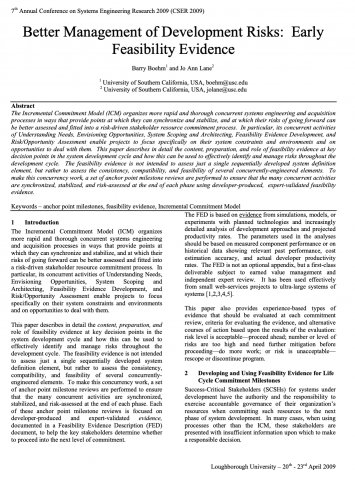The FED is based on evidence from simulations, models, or
experiments with planned technologies and increasingly
detailed analysis of development approaches and project
productivity rates. The parameters used in the analyses
should be based on measured component performance or on
historical data showing relevant past performance, cost
estimation accuracy, and actual developer productivity
rates.
A shortfall in feasibility evidence indicates a level of
program execution uncertainty and a source of program
risk. It is often not possible to fully resolve all risks at a
given point in the development cycle, but known,
unresolved risks need to be identified and covered by risk
management plans, including the necessary staffing and
funding to address them. The nature of the evidence
shortfalls, the strength and affordability of the risk
management plans, and the stakeholders’ degrees of risk
acceptance or avoidance will determine their willingness to
commit the necessary resources to proceed. A program
with risks is not necessarily bad, particularly if it has strong
risk management plans. A program with no risks may be
high on achievability, but low on ability to produce a timely
competitive advantage.
A program more familiar with a sequential waterfall or Vmodel
can achieve most of the effect of a FED-based
anchor point milestone review by adding a FED to the set
of artifacts to be developed and reviewed for adequacy and
satisfaction at a System Requirements Review (SRR),
System Functional Review (SFR), or Preliminary Design
Review (PDR). In principle, some guidance documents
indicate that such feasibility evidence should be produced
and reviewed. But since the evidence is not generally
specified as a developer deliverable and is vaguely defined,
it is generally inadequate as a basis for stakeholder
commitments.
Defines standard
Replaced/Superseded by document(s)
Cancelled by
Amended by
| File | MIME type | Size (KB) | Language | Download | |
|---|---|---|---|---|---|
| usc-csse-2009-501.pdf | application/pdf | 891.47 KB | English | DOWNLOAD! |

